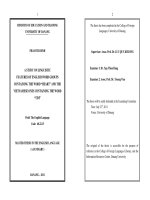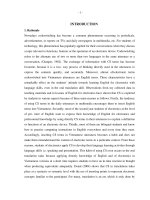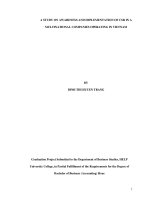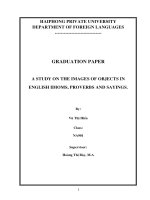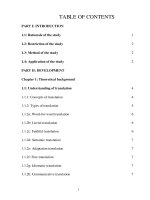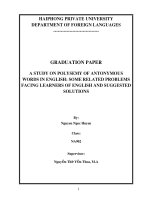a study on projection and its realization in president barack obama’s speech at a campaign event in las vegas
Bạn đang xem bản rút gọn của tài liệu. Xem và tải ngay bản đầy đủ của tài liệu tại đây (567.92 KB, 67 trang )
VIETNAM NATIONAL UNIVERSITY, HANOI
UNIVERSITY OF LANGUAGES AND INTERNATIONAL STUDIES
FACULTY OF POST-GRADUATE STUDIES
TRẦN HỒNG VÂN
A STUDY ON PROJECTION AND ITS
REALIZATION IN PRESIDENT BARACK OBAMA’S
SPEECH AT A CAMPAIGN EVENT IN LAS VEGAS
NGHIÊN CỨU VỀ PHÓNG CHIẾU VÀ SỰ THỂ HIỆN CỦA NÓ
TRONG BÀI PHÁT BIỂU CỦA TỔNG THỐNG BARACK
OBAMA TẠI CUỘC VẬN ĐỘNG TRANH CỬ Ở LAS VEGAS
M.A. Minor Programme Thesis
Field: English Linguistics
Code: 60 22 15
Hanoi – 2013
VIETNAM NATIONAL UNIVERSITY, HANOI
UNIVERSITY OF LANGUAGES AND INTERNATIONAL STUDIES
FACULTY OF POST-GRADUATE STUDIES
TRẦN HỒNG VÂN
A STUDY ON PROJECTION AND ITS
REALIZATION IN PRESIDENT BARACK OBAMA’S
SPEECH AT A CAMPAIGN EVENT IN LAS VEGAS
NGHIÊN CỨU VỀ PHÓNG CHIẾU VÀ SỰ THỂ HIỆN CỦA NÓ
TRONG BÀI PHÁT BIỂU CỦA TỔNG THỐNG BARACK
OBAMA TẠI CUỘC VẬN ĐỘNG TRANH CỬ Ở LAS VEGAS
M.A .Minor Programme Thesis
Field: English Linguistics
Code: 60 22 15
Supervisor: Prof. Dr. Hoàng Văn Vân
Hanoi - 2013
iv
TABLE OF CONTENTS
DECLARATION i
ACKNOWLEDGEMENTS ii
ABSTRACT iii
TABLE OF CONTENTS iv
NOTATIONAL CONVENTIONS vi
LIST OF TABLES vii
PART A: INTRODUCTION 1
1. Rationale of the study 1
2. Aim of the study 2
3. Research question 2
4. Scope of the study 2
5. Methods of the study 2
6. Design of the study 2
PART B: DEVELOPMENT 4
CHAPTER 1 4
1.1. Introduction 4
1.2. An overview of systemic functional grammar 4
1.2.1. Review of related studies 5
1.2.2. Three metafunctions of a language 7
1.2.2.1. Interpersonal metafunction 7
1.2.2.2. Textual metafunction 8
1.2.2.3. Ideational metafunction 8
1.3. The notion of clause complex and projection in SFG 10
1.3.1. The notion of clause complex in SFG 10
1.3.1.1. Taxis 11
1.3.1.2. Logico-semantic relation 12
1.3.2. The notion of projection in SFG 14
1.3.2.1. Level of projection 14
1.3.2.2. Mode of projection 15
v
1.3.2.3. Speech function of projection 15
1.3.3. Paratactic projection 16
1.3.4. Hypotactic projection 19
1.3.5. Embedded projection 22
1.4. Summary 24
CHAPTER 2 26
2.1. Introduction 26
2.2. The chosen text 26
2.3. A register analysis of the text 27
2.3.1. Field 27
2.3.2. Tenor 28
2.3.3. Mode 28
2.4. The realization of projection in President Obama‟s Speech 28
2.4.1. An overview 28
2.4.2. Analysis 30
2.4.2.1. Hypotactic projection 30
2.4.2.2. Paratactic projection 38
2.4.2.3. Embedded projection 39
2.5. Summary 40
PART C: CONCLUSION 42
1. Recapitulation 42
2. Implications 44
3. Suggestion for further study 45
REFERENCES 46
APPENDIX 1 I
APPENDIX 2 IX
vi
NOTATIONAL CONVENTIONS
Boundary markers
||| : clause complex boundary
|| : clause boundary
Types of dependency
1, 2, 3, …: Parataxis
α, β, γ, …: Hypotaxis
Logico-semantic relations
Expansion:
= : Elaboration
+ : Extension
x : Enhancement
Projection:
“ : Locution
„ : Idea
Others
1
st
, 2
nd
, 3
rd
, …: number of clause complex in the text
(1), (2), (3), …: number of clause in the text
vii
LIST OF TABLES
Page
Table 1
:
Relation between clauses in clause complexes
13
Table 2
:
Projection of propositions and proposals
16
Table 3
:
Positions of projecting clauses
17
Table 4
:
Verbs used in projecting clauses
17
Table 5
:
Quoting and paratactic reporting
18
Table 6
:
Paired verbs of the like type and the please type
20
Table 7
:
Verbs serving in hypotactic projection
21
Table 8
:
Projection nouns and fact nouns
22
Table 9
:
The realization of projection in President Obama‟s Speech
29
Table 10
:
Meaning of the reported statements in the projection of idea
30
Table 11
:
Meaning of the reported statements in the projection of
locution
35
1
PART A: INTRODUCTION
1. Rationale of the study
Language is the central study of linguistics. It is a system of communication
that is made of speech or writing. It emphasizes the “arrangement of sounds or
written representation into larger units, e.g. morphemes, words, sentences,
utterances” (Richards et al., 1992). This arrangement is known as grammar. Crystal
(2004) emphasizes the importance of grammar in a language. It is as important as
the skeleton, the heartbeat, the nervous system and the intelligence of a language,
because without grammar, there can be no meaningful or effective communication
(Crystal, 2004). Grammar is the foundation for people to express themselves. If
people can understand the way grammar works, they are sure to be able to use a
language effectively. Hence, grammar is not only important for teachers or students,
but it has a particular significance for anyone who wants to master a language
(Crystal, 2004). Knowing the importance of grammar, many scholars are engrossed
in studying it. The linguistics history has seen many trends of grammar with their
advantages and disadvantages such as traditional grammar, universal grammar and
generative grammar by Noam Chomsky and his followers. However, the most
popular trend of grammar is functional grammar that is developed by Halliday and
some other linguists such as Hassan, Morley, Bloor, etc. While other trends of
grammar focuses on the rules of wordings, functional grammar is concerned with
the meaning and functions of a language.
In Vietnam, functional grammar is studied by such grammarians as Cao
Xuân Hạo (1991) with Tiếng Việt: Sơ thảo Ngữ pháp chức năng and Hoàng Văn
Vân (2005) with Ngữ pháp kinh nghiệm của cú tiếng Việt: Mô tả theo quan điểm
chức năng hệ thống.
In Faculty of Postgraduate Studies, students have a chance to take an
approach to functional grammar to discover new features of this innovative trend of
grammar. For the author, what attracts her the most is projection. That is the reason
why she chooses to analyze the realization of projection in a speech by President
2
Obama. It is expected that the analysis of projection will reveal the underlying
meaning of the President‟s speech.
2. Aim of the study
The aim of the study is to explore how different types of projection are
realized in President Obama‟s speech at a Campaign Event in Las Vegas. In order
to achieve this aim, an overview of the key concepts of functional grammar relevant
to the study is in need of exploration to provide the theoretical framework for the
analysis.
3. Research question
With such an aim as mentioned, the following question is raised for
exploration:
How are projections realized in President Obama’s speech at a Campaign Event
in Las Vegas?
4. Scope of the study
In order to make the most convenience for the author, the study only focuses
on exploring one of the two subtypes of logico-semantic relations between clauses:
projection. The text chosen for analysis is President Obama‟s speech at a Campaign
Event in Las Vegas on October 24
th
, 2011.
5. Methods of the study
This study uses two main methods: descriptive method and analytical
method. The descriptive method is used to re-examine the basic notions of systemic
functional grammar and, in particular, the notion of projection in the clause
complex. The analytical method, on the other hand, is employed to analyze
President Obama‟s speech to reveal the different logico-semantic meanings of the
text.
6. Design of the study
The study is divided into 3 parts:
Part A – Introduction – presents the rationale, the aim, the research
questions, the scope, the methods and the design of the study.
3
Part B – Development – consists of 2 chapters. Chapter 1 – Theoretical
background presents the overview of systemic functional grammar and the notions
of clause complex and projection. Chapter 2, the main chapter of the thesis,
explores the realization of projections in President Barack Obama‟s speech at a
Campaign Event in Las Vegas.
Part C – Conclusion – recapitulates the results of the study. In this part, the
author reviews such concepts as systemic functional grammar, metafunctions of
language, clause complex and two logico-semantic relations in clause complex.
More importantly, the analysis of President Obama‟s speech in terms of projection
is summarized in part C. This last part also makes some implications for teaching
and learning English and some suggestions for further study.
4
PART B: DEVELOPMENT
CHAPTER 1
THEORETICAL BACKGROUND
1.1. Introduction
In the first chapter of the study, the author attempts to present some concepts
of systemic functional grammar including three metafunctions of a language and to
review some related studies. The main content of this chapter is the notion of clause
complex and projection. In the clause complex, the logico-semantic relations
between clauses are focused because one of the two logico-semantic relations,
projection, is the main interest of the study.
1.2. An overview of systemic functional grammar
Language is an important tool in our life. We use it not only to make
ourselves understood but also to maintain a relationship with other people in our
society. Grammar is part of a language. According to Matthiessen & Halliday
(1997), grammar is “the system of wordings of a language”. However, the
interpretation of how a language is worded depends on different theories of
grammar. In linguistics history, there have been many trends of grammar, most of
which began with European languages such as Greeks, Romans or Latin. These
grammar trends are mainly based on the two theoretical perspectives. Those who
are in favor of the first viewpoint consider language “a set of rules” and grammar is
a structure to specify those rules. From this perspective, it is important to define
which parts of a sentence function as Subject, Predicate, Object or Adverbial. This
kind of grammar is often taught at school because it is suitable for young students to
study a language. Despite its comprehensibility, it is isolated from its meaning.
Besides that, it does not convey the whole “grammatical system of language” but
just “a fragment of grammar”. On the other hand, because it is originated from
European languages, it focuses on describing these languages. Hence, it is difficult
to apply this grammar to non-European languages such as Chinese, Japanese or
Vietnamese (Matthiessen & Halliday, 1997). In that context, it is required that there
5
should be another kind of language that is more meaningful and can be applicable in
a wider range.
Systemic functional grammar (SFG) has found the answer to this demand.
This kind of grammar is an outstanding representative for the second perspective of
grammar and was originally developed by Halliday. In this concept, it is necessary
to understand what it means by “systemic” and “functional”. “Systemic theory gets
its name from the fact that the grammar of language is represented in the form of
system networks, not as an inventor of structures” (Halliday & Matthiessen, 2004:
23). This means that systemic grammar does not merely describe the structure of a
language, but it is also a set of choices to make meaning. The term “functional”
refers to Halliday's view that language is as it is because of what it has evolved to
do. In a functional grammar, “a language is interpreted as a system of meanings,
accompanied by forms through which the meanings can be realized” (Halliday,
1994). Functional grammar is not the ultimate goal of grammarians like what is
expressed in traditional perspective; whereas, it is just a means to convey the
meaning of a language. All in all, Halliday (1994) defines SFG as “a network of
systems, or interrelated sets of options for making meaning”. In his book, SFG is
called “natural grammar in the sense that everything in it can be explained,
ultimately, by reference to how language is used” (Halliday, 1994). Functional
grammar can be considered one of the most successful trends of grammar as it is
closer to people‟s communicative language. It not only mentions form and meaning
of a language but also the relationship between them (Thompson, 1996: 6). In
functional grammar, there is no “right” or “wrong” in terms of structure like in
traditional grammar, but functional grammarians only consider something
“appropriate” or “inappropriate” to achieve high effectiveness in language (Eggins,
1994: 22).
1.2.1. Review of related studies
The founder of SFG is M.A.K Halliday (1994) with a famous book An
Introduction to Functional Grammar. In this book, he explores the clause as
6
message, the clause as exchange and the clause as representation, which correspond
to textual metafunction, interpersonal metafunction and ideational metafunction.
Besides the clause, the author presents some concepts about below, above and
beyond the clause such as groups and phrases, the clause complex, intonation and
rhythm and cohesion and discourse. These concepts are considered the theoretical
foundation for many of his followers to base on in their research and publications.
Ten years later, Mathiessen (2004) revises Halliday‟s book with more specifications
and examples to illustrate the concepts. Some other scholars such as Eggins (1994),
Bloors (1995), Thompson (1996), Martin, Mathiessen and Painter (1997) also pay
much attention to SFG. While Thompson (1996) focuses on analyzing examples to
clarify some concepts of SFG, Martin, Mathiessen and Painter (1997) provides
some exercises for students to work with functional grammar. In Eggin‟s (1996)
book, she focuses more on some concepts such as genre or register. Bloors (1995)
attempt to analyze English in the light of SFG.
In Vietnam, the history of research on Vietnamese grammar dates back to
long ago. However, the very first studies of Vietnamese grammar were just some
simple notes of different parts of speech or the role of word order, etc. in the
bilingual dictionaries developed by Western scholars in order to teach Vietnamese
grammar to foreigners (Nguyen Thi Minh Tam, 2012). Later, there appeared some
scholars who paid much attention to specific areas in Vietnamese language such as
Nguyen Tai Can (1975): Vietnamese noun and compound words, Nguyen Kim Than
(1977): Vietnamese verbs and verb phrases, Diep Quang Ban (1984): Vietnamese
sentences and Tran Ngoc Them (1985): Cohesion in Vietnamese texts. The first
Vietnamese linguist to study Vietnamese grammar in the light of SFG is Cao Xuan
Hao (1991) with his book Tiếng Việt: Sơ thảo Ngữ pháp Chức năng which was then
reprinted in 2007. His works gave an overview of SFG and analyzed Vietnamese
grammar basing on this theoretical framework. Besides that, the PhD dissertations
by Hoang Van Van (1997) An Experiential Grammar of the Vietnamese Clause: A
Functional Description and Thai Minh Duc (1998) A Metafunction Profile of
7
Vietnamese Clause Grammar analyzed in depth the Vietnamese grammar basing on
the theoretical framework of SFG (Nguyen Thi Minh Tam, 2012). More recently,
Do Tuan Minh (2007) studied the thematic structure of English and Vietnamese in
his PhD dissertation and Nguyen Thi Minh Tam (2012) investigated the logico-
semantic relationship in English and Vietnamese clause complexes. However, there
are hardly any studies analyzing the projection, one of the two logico-semantic
relationships in a specific text.
1.2.2. Three metafunctions of a language
In Halliday‟s view on SFG, he mentions three metafunctions of a language,
namely ideational metafunction, interpersonal metafunction and textual
metafunction. It is obvious that language can make various meanings
simultaneously. The meaning of a language is not the sum of individual words but it
depends on other factors such as the arrangement of words in a text. Hence,
different wordings will make different meanings. Three metafunctions express three
kinds of meaning which are the way people use language to make sense of their
experience, act out their social relationship and organize their messages in a
network where they are suitable to other messages around them. Halliday calls these
functions “metafunctions” because “function simply means purpose or way of using
language and has no significance for the analysis of language itself” (Halliday &
Hasan, 1985; Martin, 1990 cited in Halliday & Matthiessen, 2004).
1.2.2.1. Interpersonal metafunction
People use languages to establish and maintain the social relationship with
other people. The metafunction of language that expresses the interaction between
speakers and addressees is called interpersonal metafunction. People can use their
language to ask a question, to make an order, an offer or to express their emotion
towards other people and other things.
Interpersonal metafuntion is realized through the Mood system. The mood
element consists of two parts: (1) the Subject, which is a nominal group, and (2) the
Finite operator, which is part of a verbal group (Halliday & Matthiessen, 2004:
8
111). The remainder of the clause is called Residue constituted by three elements:
Predicator, Complement and Adjunct. The following example is analyzed on the
basis of interpersonal metafunction:
It
has
hurt
me
so much.
Subject
Finite
Predicator
Complement
Adjunct
Mood
Residue
1.2.2.2. Textual metafunction
While interpersonal metafunction enacts the social world, textual
metafunction is connected to the presentation of ideational and interpersonal
metafunctions. As Halliday & Matthiessen (2004: 30) emphasizes in their book, it
“builds up sequences of discourse, organizes the discursive flow and creates
cohesion and continuity”. Textual metafunction is not extra-linguistic phenomena,
but it is intrinsic to language, which means that it is a phenomenon created by
language itself. When the text flows change, the message of the text may also vary.
When a clause is analyzed basing on textual metafunction, it is necessary to focus
on Theme and Rheme. “The Theme is the element which serves as the point of
departure of the message; it is that which locates and orients the clause within its
context. The remainder of the message, the part in which the Theme is developed, is
called the Rheme” (Halliday & Matthiessen, 2004: 64). It can be seen that a
message or a clause consists of a Theme accompanied by a Rheme; and in English
the Theme is in the initial position. The following example illustrates textual
metafunction basing on the analysis of Thematic structure:
The duke
My aunt
That teapot
has given my aunt that teapot.
has been given that teapot my the duke.
the duke has given to my aunt.
Theme
Rheme
1.2.2.3. Ideational metafunction
The most important metafunction of a language is to construe the natural
world and this metafunction is called ideational metafunction by Halliday &
9
Matthiessen (2004: 29). This metafunction is distinguished into two components:
experiential metafunction and logical metafunction.
Experiential metafunction is concerned with content or ideas. In Halliday‟s
theory, experiential metafunction is realized through the system of transitivity. He
emphasizes that “transitivity system construes the world of experience into a
manageable set of process types”, namely material process, mental process,
relational process, behavioral process, verbal process, and existential process
(Halliday & Matthiessen, 2004: 170). In each process, he continues to analyze the
participants and circumstances taking part in the process.
Logical metafunction is the relationship between the expressed ideas. It is
realized through the relationship of coordination (parataxis) or subordination
(hypotaxis) between the two clausal units. The example below illustrates the
experiential and logical metafunction of a clause:
Peter
says
that
he
was
an engineer.
Sayer
Process: Verbal
Carrier
Process: relational
Attribute
||| Peter says || that he was an engineer. |||
α “β
In summary, three metafunctions of language play a very important role in
functional grammar. They are closely related and “they all contribute to the overall
meaning and structure of the text” (Morley, 2000: 16). In order to see the
relationship between three metafunctions, an example is analyzed in relation to
transitivity, mood and thematic structure. In the following sections, the author will
focus on the logical metafunction of clause complex which is the main interest in
the study.
Meta-
-function
System
At last
he
returned
to his
palace
quite
cast
down.
Idea-
-tional
TRANSI-
-TIVITY
Location
Actor
Material
Process
Location
Manner
10
Inter-
-personal
MOOD
Subject
Finite
Predi-
-cator
Adjunct
Adjunct
Mood
Residue
Textual
THEME
Theme
Rheme
1.3. The notion of clause complex and projection in SFG
1.3.1. The notion of clause complex in SFG
Functional grammarians pay much attention to the notion “rank scale”
related to “constituency” “whereby larger units are made up out of smaller ones”
(Halliday & Matthiessen, 2004:5). There exists the rank scale in the grammar of
every language. In English, the rank scale can be represented as below:
Clause
Phrase/ group
Word
Morpheme
Unit rank scale in English
Each unit of rank can consist of one or more units of the rank next below. It
can form complexes, hence, functional grammar may be concerned with clause
complexes, phrase complexes, group complexes, word complexes and even
morpheme complexes (Halliday & Matthiessen, 2004: 9).
It can be seen that a clause is the largest unit of the rank scale. It is also a
basic unit in functional grammar. As Bloor (1995) emphasizes, it is at this rank that
people start to exchange information and interact with each other (Bloor, 1995: 7).
From Hallidayan linguists‟ perspective, clauses include clause simplexes and clause
complexes. As it is called, a clause simplex consists of only one clause while a
clause complex is a combination of “a Head clause and other clauses that modify it”
(Halliday, 1994: 215). A clause complex is equivalent to the concept “sentence” in
traditional grammar. However, sentence is just “a constituent of writing”, but a
clause complex is “a constituent of grammar” (Halliday, 1994: 216). Halliday‟s
view obviously shows that in functional grammar, it is necessary to focus on clause
11
or clause complex to see the relations between these grammatical units rather than
mentioning the term “sentence”.
As mentioned above, the relationship between clauses is the realization of
logical meaning of ideational metafunction. According to Halliday & Matthiessen
(2004: 373), clauses are interrelated in terms of the degree of interdependency or
taxis and the logico-semantic relation.
1.3.1.1. Taxis
It cannot be denied that all clauses are linked together by grammatical
relations. Some clauses are equal to each other, but some are of unequal status.
When the two clauses are equal, Halliday & Matthiessen (2004: 374) calls relation
“parataxis” in which one clause is initiating and the other continuing. Contrary to
“parataxis” is “hypotaxis”, the relation between a dependent clause and its dominant
clause.
In parataxis, clauses are independent of one another. According to Halliday
(1994:221), “the paratactic relation is logically symmetrical and transitive”. The
example below shows the characteristics of paratactic relation:
||| Kukul crouched low to the ground || and moved slowly. |||
1 2
(Halliday & Matthiessen, 2004:373)
Hypotaxis is the relation between two clauses where one is considered the
main clause and one is the dependent clause or “qualification” in Halliday‟s words.
The following example illustrates hypotactic relation:
||| As he came to a thicket, || he heard the faint rustling of leaves. |||
β α
Interestingly, in clause complexes, parataxis or hypotaxis does not exist
separately but there is a mixture of parataxis and hypotaxis. This is called “clause
nexus” by Halliday (2004:375). The clauses making up clause nexus are primary
and secondary clauses. The clauses making up clause nexus are primary and
secondary clauses. The primary may be the initiating clause in a paratactic nexus or
12
the dominant clause in a hypotactic while the secondary is the continuing clause in
parataxis or the dependent clause in hypotaxis. The mixture of parataxis and
hypotaxis in clause nexus can be illustrated in the following example:
||| I would || if I could, || but I can‟t. |||
1α 1β 2
(Halliday & Matthiessen, 2004:376)
1.3.1.2. Logico-semantic relation
There is a wide range of logico-semantic relations between primary and
secondary clauses in a clause nexus; however, it can be summarized as two kinds:
expansion and projection.
Expansion is the relationship where the secondary clause expands the
primary clause by elaborating it, extending it or enhancing it. In elaboration, one
clause does not add new information to the other clause but specify, clarify and
describe what has been said in the primary clause instead.
||| She sang poorly, || the audience was bored with her voice. |||
1 =2
On the other hand, extension is the relation when the secondary clause adds
new information to the primary clause.
||| I am tired || and I don‟t want to have breakfast. |||
1 +2
The third type of expansion is enhancement in which the qualifying clause
enhances the main clause by adding some information relating to “time, place,
manner, cause or condition” (Halliday & Matthiessen, 2004: 410).
||| I came || when he had left. |||
α xβ
Different from expansion, in projection, “the secondary clause is projected
through the primary clause, which instates it as a locution or an idea” (Halliday &
Matthiessen, 2004: 377). While locution is connected with verbal process (what
13
people say), idea is related to mental process (what people think). The following
clause complexes give an example of projection:
||| John said: || “I‟m running away.” |||
1 “2
||| John thought || he would run away. |||
α „β
(Halliday & Matthiessen, 2004: 380)
Both expansion and projection relation are either paratactic or hypotactic.
The table below shows an example of relationship between clauses in clause
complexes including taxis and logico-semantic relation:
(i) paratactic
(ii) hypotactic
(1) expansion
(a) elaboration
1 John didn‟t wait;
=2 he ran away.
α John ran away,
=β which surprised
everyone.
(b) extension
1 John ran away,
+2 and Fred stayed
behind.
α John ran away,
+β whereas Fred
stayed behind.
(c) enhancement
1 John was scared,
X2 so he ran away.
α John ran away,
xβ because he was
scared.
(2) projection
(a) locution
1 John said:
“2 “I‟m running away”
α John said
“β he was running
away.
(b) idea
1 John thought to
himself:
„2 „I‟ll run away‟
α John thought
„β he would run away.
Table 1: Relation between clauses in clause complexes
(Halliday & Matthiessen, 2004: 380)
14
1.3.2. The notion of projection in SFG
As it was mentioned in the previous part, projection is one of the two logico-
semantic relations between clause complexes which does not directly express non-
linguistic experience but interpret linguistic representation instead (Halliday &
Matthiessen, 2004: 441). In projection, people tend to include the wording or
meaning of an original event rather than express their own experience. Projection is
often applied to quote source in a report, to give attitude in a text, to make a
conversation or ask a question (Halliday & Matthiessen, 2004: 442). Among six
processes in SFG, only two of them, mental process and verbal process are
capable of projecting other clauses. Mental process interprets what people feel,
think, and see in their experiential world. There are two participants in mental
process, namely senser who can feel or perceive the world with consciousness, and
phenomenon, something that is “felt, thought, wanted or perceived” (Halliday &
Matthiessen, 2004: 203). On the other hand, verbal process allows people to quote
or report sources of information. It is the process of saying including the sayer, the
receiver and the verbiage. It can be considered the most popular process in
projection. The examples of mental process and verbal process are shown below:
I
learned
that lesson
a long time ago.
Senser
Process: mental
Phenomenon (thing)
Circumstance
(Halliday & Matthiessen, 2004)
I
told
the story
to
my parents.
Sayer
Process: verbal
Verbiage
Receiver
Each projection process is realized through projecting element and projected
element. In fact, there are three systems involving the categorization of projection:
the level of projection, the speech function of projection and the mode of
projection.
1.3.2.1. Level of projection
The two processes mentioned above directly affect level of projection. If the
projecting clause is verbal process, then the projected clause is called “locution”,
15
whereas if the projecting clause is a mental process, the projected clause is “idea”.
“Locution” and “idea” constitute two levels of projection. For example, in the
clause complex “John said that she was beautiful”, “she was beautiful” is a
locution, while in “John thought that she was beautiful”, “she was beautiful” is an
idea. It can be said that locution is the projection of wording and idea is the
projection of meaning (Halliday & Matthiessen, 2004: 443).
1.3.2.2. Mode of projection
As it was mentioned in the previous part, taxis and logico-semantic relations
are two kinds of relationship between clauses. When projection is in combination
with taxis, we have paratactic projection and hypotactic projection which are
conceptualized as mode of projection. Paratactic projection is known as quoting
where the projected clause is directly quoted. In contrast, hypotactic projection is
similar to reporting in which the projected clause is indirectly reported.
||| The girl said: || “I saw a young man in the house.” |||
1 “2
||| The girl thought || that there was something wrong with her. |||
α „β
Mode of projection does not stop at paratactic and hypotactic projection but
expands to embedded projection. In embedded projection, the projected clause is
down-ranked to become the post-modifier for its preceding noun.
||| I agree with the idea [[that we will go for a picnic.]] |||
α „β
These modes of projection will be discussed thoroughly in the following
sections.
1.3.2.3. Speech function of projection
The projected clauses can function as statements, questions, offers or
commands. The two former ones form projected proposition while the latter are
called projected proposal by Halliday & Matthiessen (2004: 444). In paratactic
projection, the projected clause may be not only propositions and proposals but also
16
some minor speech functions such as greetings and exclamations. Some examples
of projection of propositions and proposals are shown in the following table:
Type of projecting
Process
Projected speech
Function
Quote paratactic 1 2
Report hypotactic
α β
Idea „mental
Major:
proposition
1 „2 She thought, „I
can‟
α „β She thought
she could
Major: proposal
He willed her „Do‟
He wanted her to
do
Locution “verbal
Major:
proposition
1 “2 She said, “I
can”
α “β She said she
could
Major: proposal
He told her “Do”
He told her to do
Minor
1 “2 She said,
“Wow!”
-
Table 2: Projection of propositions and proposals
(Halliday & Matthiessen, 2004: 445)
1.3.3. Paratactic projection
Paratactic projection is a kind of projection in which projecting clause and
projected clause are of equal status. It means that projected clause does not depend
on projecting clause in terms of mood, reference, register or dialect…. The
projected clause focuses on the wording of an original language event. It possesses
all the features of the clause as exchange such as the mood or the tone selection and
it can occur alone, without the appearance of the projecting clause. In the clause
complex “He says that “I am an architect.””, the projecting clause “He says”
represents an ordinary phenomenon of experience, while the projected clause “that
“I am an architect” represents a second-order phenomenon. It is so-called
“metaphenomenon” by Halliday & Matthiessen (2004: 447).
||| He says || that “I am an architect”. |||
1 “2
17
In paratactic projection, the projecting clause may vary in position, that is,
they can precede the projected one, stand in the middle or come after the projected
one. When projecting clause comes after the projected, there might be an inversion
of the reported verb and the Sayer, but it is largely restricted to some formal
planned texts, usually published writing (Bloor, 1995:202). The table below shows
the various positions of projecting clause in paratactic projection:
Initial
1 ^ “2
Brutus said:
1
“Caesar was ambitious.”
2
Middle
“1 <<2>>
“Caesar”
1
said Brutus
2
“was ambitious.”
1
Final
“1 ^ 2
“Caesar was ambitious”
1
said Brutus.
2
Table 3: Positions of projecting clauses (Halliday & Matthiessen, 2004: 446)
In paratactic projection, the verb “say” is the general member of the group.
Besides that, there are many other verbs which add more connotation meaning to
themselves. The following table illustrates the verbs for paratactic projection of
both propositions and proposals:
Proposition
Proposal
(1) general
verb
say
say
(2) verbs
specific to
speech
function:
(a) statements: tell, remark,
observe, point out, report,
announce
(a) offers: suggest, offer;
threaten, vow, promise, agree
(b) questions: ask, demand,
inquire, query
(b) commands: call, order,
request, tell, propose, decide;
urge, plead, warn
(3) verbs with
additional
circumstantial
reply, explain, protest,
continue, add, interrupt, warn,
insist, complain, cry, shout,
suggest, offer; threaten, vow,
promise, agree, call, order,
request, tell, propose, decide;
18
feature:
boast, murmur, stammer
urge, plead, warn, blare,
thunder, moan, yell, fuss
Table 4: Verbs used in projecting clauses (Halliday & Matthiessen, 2004: 448)
The author has just mentioned the paratactic projection or quoting of
locutions (verbal process); however, there still exists the quoting of ideas (mental
process). Although it is quite restricted, it will be insufficient not to mention it. For
example:
||| “The gods must watch out for Kukul,” || he thought to himself. |||
„1 2
The projected clause in this case represents what one can think in words. Not
all mental verbs are able to be used in quoting ideas except some certain verbs such
as think, wonder, reflect, surmise.
Paratactic projection is not only realized through quoting but also through
paratactic reporting. Paratactic reporting can be considered the blended type
between quote and report because it appears as a part of a report but still retains
some interactive features of the original speech event. If quoting is traditionally
called “direct speech”, paratactic reporting is traditionally call “free indirect
speech”. Free indirect speech can be projected verbally and mentally and includes
both propositions and proposals.
Process
types
Speech
function
Quoting
(direct)
Paratactic reporting
(free indirect)
Verbal
Proposition
Proposal
“1 2
“I can”, he said.
“Are you sure?” asked Fred.
“Wait here,” she told him.
He could, he said.
Was she sure, Fred asked.
Wait there, she told him.
Mental
Proposition
„1 2
„I can‟, he thought.
„Am I dreaming?‟ wondered
Jill.
He could, he thought.
Was she dreaming, Jill
wondered.
19
Proposal
„Wait here,‟ she willed him.
Wait there, she willed him.
Table 5: Quoting and paratactic reporting (Halliday & Matthiessen, 2004: 466)
In short, in paratactic projection, projected clause keeps the original wording
of the speech event. Projecting clause and projected clause are independent from
each other. Both verbal clause and mental clause are capable of paratactically
projecting other clauses. When we mention paratactic projection, it is not only
quoting but also paratactic reporting which is called free indirect speech in
traditional grammar.
1.3.4. Hypotactic projection
Contrary to paratactic projection, hypotactic projection is the projection in
which the projected clause is dependent on the projecting one. Halliday &
Matthiessen (2004: 449) calls the projecting clause phenomenon and the projected
one metaphenomenon because the projected clause is a phenomenon of language.
While paratactic projection tends to represent the exact words, hypotactic projection
tries to interpret the gist or the main idea of the original clause. It means that the
projected clause in hypotactic projection is more focused on meaning than wording.
It is obvious that we use language not only to talk but also to think, hence,
hypotactic projection is the most typically applied to mental process with two sub-
types: (1) cognition and (2) desideration.
(1) cognition
||| Do you know || where the scissors are? |||
α „β
(2) desideration
||| I want || him to go out. |||
α „β
For cognition hypotactic projection is applied in both (a) like type and (b)
please type, two ways to express mental process without changing the active voice
of clauses. For example:
(a) like type
